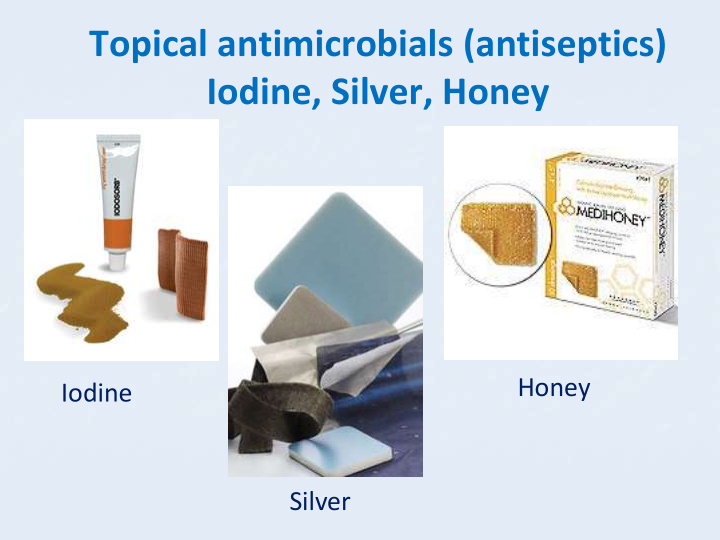



Topical antimicrobials (antiseptics) Iodine, Silver, Honey Honey Iodine Silver
Enzymatic debridement ◼ Proteolytic enzyme, also called Proteinase ◼ Proteinase breaks the long chainlike molecules of proteins into shorter fragments (peptides) and eventually into their components, amino acids ◼ Patients with chronic wounds have been treated since hundreds of years topically with proteolytic enzymes (fruit juices i.e. kiwi, papaya fruit extracts) Not registered for use on wounds in NZ! ◼
Biosurgical debridement ◼ Biosurgical debridement is the use of sterile maggots or larvae ◼ The sterile larvae of the green bottle fly Lucila sericata ◼ Maggot secretions contain antibacterial substances that reduce bacterial load ◼ Proteolytic enzymes cause eschar degradation ◼ Promote wound healing
Debridement Quality cycle www.ewma.com
Patient Treatment Outcome 83 year old female, 4 debridement's with LFUD, NPWT Healing well, treated with intrasite Alzheimer's, Diabetes, poor conformable, rocker boot control, non healing amputation of 4ht and 5 th toe 4 month ago 1. 3. Left 4 th , 5 th metatarsal 2. ? 5 . 4.
Sharp and Surgical Debridement The rapid removal of necrotic tissue with blade or scissors • Sharp debridement is conservative frequently leaving a thin margin of necrotic tissue • Surgical debridement is more extensive, converting a chronic to an acute wound
Sharp debridement ◼ Know and understand the anatomy ◼ Be able to recognize structures and distinguish viable tissue ◼ Have adequate equipment, access, lighting and assistance ◼ Obtain informed consent ◼ Manage pain and discomfort ◼ Be able to deal with complications ◼ Recognize your and the techniques limitations
Sharp Curette Debridement
Disposable Curette
LOW FREQUENCY ULTRASOUND DEBRIDEMENT • Low-frequency ultrasound can provide a debridement alternative for surgical debridement • Ultrasonic waves are also claimed to lead to destruction of bacteria and disruption of biofilms
Debridement Quality cycle www.ewma.com
Define your method of debridement
Define your dressing plan – antimrobial Ask ‘what do I want the dressing to do…?’ Rehydrate? Absorb exudate? Deslough? Reduce bacterial contamination? Promote granulation? Promote a moist / dry wound bed
Adjunct treatment – compression bandaging
Review and adjust Patient Treatment Outcome VLU, SSG failed twice, LFUD, silver dressings, PICO, 47.8 cm2 now down to 8.9 cm2 painful, not able to sleep or compression bandaging, stockings tolerate compression
Summary ◼ Debridement has a pivotal role in the progression of a wound to granulation, contraction and epithelisation ◼ Debridement must be understood as an ongoing process in conjunction with other treatment approaches ◼ Aim is to create a beneficial situation supporting various clinical goals related to wound management ◼ Form of debridement depends on type of tissue, the tools available and the clinical environment ◼ The clients quality and stage of life must be part of the care planning
From your Wound Care Nurse Have a lovely day !
Patient Treatment Outcome 75 year old female, history of Admitted acutely for pain and infection, SSG, complete healing 45 years on and off venous leg debrided twice with LFUD under LA , ulcers, 4/12 old VLU medial NPWT, compression bandaging right malleolus, Left medial 4.5 cm by 3.6 cm
Patient Treatment Outcome 75 year old female, 6/12 old, Debrided on the ward using EMLA 5 % SSG, 100 % take and survival large medial maleolus right leg ulcer, ABPI 0.55, diabetes, 13. 7 by 12. 8 cm right gaiter Day 10 Day 6
Patient 13 Treatment Outcome 82 year female, history of NPWT, SSG after several treatments 95 % healed skin graft, able to wear increasing very painful left leg with EMLA + LA Xylocaine prior to compression stockings class 1, ulcer gaiter area, now LFUD over a 3 week period lives independently again circumferential, pain 10/10, not tolerating compression, Tendon exposure Thick, tenacious, unhealthy Granulation tissue Lateral left gaiter 12.2 cm by 11.8 cm posterior medial
3 rd treatment with LFUD - EMLA 5 % crème Tendon Lateral left gaiter medial
4 th treatment with LFUD - EMLA 5 % crème + NPWT Lateral left gaiter medial
SSG in MOT 3 wks after start of treatment, Acticoat flex + NPWT
10 days after SSG Posterior Lateral left gaiter
Debridement and TIME • T – issue • I – Infection and/or inflammation • M – oisture imbalance • E – dge
LFUD debridement of VLU
Dry fibrin - the wound edges show that fibrin represents a barrier to healing What would you do?
Dictionary • The word debridement derives from the French débridement, which means to remove a constraint • In clinical medicine this term was first used by Henri Le Dran, a French surgeon (1685 – 1770), in the context of an incision to promote drainage and relieve of tension • He stated that cancer progressed in stages, and that it began as a local organic disease. He advocated surgery for cancer before the tumor was allowed to metastasize • Also described “shock” as a treatise on gunshot wounds as a sudden impact or jolt
Amputation isn’t debridement
Wound revision isn’t debridement
Slough or necrosis delays wound healing • Prolongs the inflammatory stage of healing • Focus for infection • Impedes re- epithelialisation • Discomfort for the patient • Reduced quality of life
Branding is not debridement
Resection of functional tissue isn’t debridement Reconstruction for Soft Tissue Sarcomas of the Foot and Ankle
Antibiotics and Biofilms
How to remove Biofilm?
Moisture Balance Moist – not to wet and not to dry
Recommend
More recommend